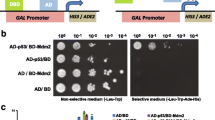Abstract
Complementation of yeast cdc and cln mutants as well as biochemical approaches have been used to identify and characterize the major components of the mammalian cell cycle machinery, the cyclins and cyclin-dependent kinases (cdks). More recently the two-hybrid system (or interaction trap) has been used to identify novel regulators of the cell cycle in which a known component of the cell cycle is used as “bait” to search for protein interactors (see chapter by Fiore et al., Part Four). For example, the latter approach was used to identify p21Cip/Waf1/Sdi1/Picl, a small molecular weight inhibitor of cdks (Harper et al. 1993), Cdi1, a dual-specificity phosphatase that interacts with both Cdc2 and Cdk2 (Gyuris et al. 1993; Hannon et al. 1994), and p16Ink4/Mts1, a Cdk4 inhibitor (Serrano et al. 1993).
Access this chapter
Tax calculation will be finalised at checkout
Purchases are for personal use only
Preview
Unable to display preview. Download preview PDF.
Similar content being viewed by others
References
Albers MW, Williams RT, Brown EJ, Tanaka A, Hall FL, Schreiber SL (1993) FKBP-rapamycin inhibits a cyclin-dependent kinase activity and Cyclin D1-Cdk association in early G1 of an osteosarcoma cell line. J Biol Chem 268:22825–22829
Bartel PL, Chien C-T, Sternglanz R, Fields S (1993) Using the two hybrid system to detect protein-protein interactions. In Hartley DA (ed) Cellular interactions in development: a practical approach. Oxford University Press, Oxford pp 153–179
Becker DM, Lundblad V (1994) In: Ausebel FM, Brent R, Kingston RE, Moore DD, Seidman JG, Smith JA, Struhl K (eds) Current protocols in molecular biology, vol 2, pp 13.7.1–13.7.2 John Wiley & Sons
Bierer BE, Mattila PS, Standaert RF, Herzenberg LA, Burakoff SJ, Crabtree G, Schreiber SL (1990) Two distinct signal transmission pathways in T lymphocytes are inhibited by complexes formed between and immunophilin and either FK506 or rapamycin. Proc Natl Acad Sci USA 87:9231–9235
Brown EJ, Albers MW, Shin TB, Ichikawa K, Keith CT, Lane WS, Schreiber SL (1994) A mammalian protein targeted by G1-arresting rapamycin-receptor complex. Nature 369:756–758
Chevray PM, Nathans D (1992) Protein interaction cloning in yeast: identification of mammalian proteins that react with the leucine zipper of Jun. Proc Natl Acad Sci USA 89:5789–5793
Chiu MI, Katz H, Berlin V (1994) RAPT1, a mammalian homolog of yeast TOR, interacts directly with the FKBP12/rapamycin complex Proc Natl Acad Sci USA 91:12 574–12 578
Dumont FJ, Melino MR, Staruch MJ, Koprak SL, Fischer PA, Sigal NH (1990) The immunosuppressive macrolides FK-506 and rapamycin act as reciprocal antagonists in murine T cells. J Immunol 144:1418–1424
Fields S, Song, O-K (1989) A novel genetic system to detect protein-protein interactions. Nature 340:245–246
Gyuris J, Golemis E, Chertkov H, Brent R (1993) Cdi1, a human G1 and S phase protein phosphatase that associates with Cdk2. Cell 75:791–803
Hannon GJ, Demetrick D, Beach D (1993) Isolation of the Rb-related p130 through its interaction with CDK2 and cyclins. Genes Dev 7: 2378–2391
Hannon GJ, Casso D, Beach D (1994) KAP: A dual specificity phosphatase that interacts with cyclin-dependent kinases. Proc Natl Acad.Sci USA 91:1731–1735
Harding MW Galat A, Uehling DE, Schreiber SL (1989) A receptor for the immunosuppressant FK506 is a cis-trans peptidyl-prolyl isomerase. Nature 341:758–760
Harper JW, Adami GR, Wei N, Keyomarsi K, Elledge SJ (1993) The p21 Cdk-interacting protein Cip1 is a potent inhibitor of G1 cyclin-dependent kinases. Cell 75:805–816
Heitman J, Movva NR, Hall MN (1991) Targets for cell cycle arrest by the immunosuppressant rapamycin in yeast. Science 253:905–909
Hoffman CS, Winston F (1987) A ten-minute DNA preparation from yeast efficiently releases autonomous plasmids for transformation of Escherichia coli. Gene 57:267–272
Koltin Y, Faucette L, Bergsma DJ, Levy MA, Cafferkey R, Koser PL, Johnson RK, Livi GP (1991) Rapamycin sensitivity in Saccaromyces cerevisae is mediated by a peptidylprolyl cis-trans isomerase related to human FK506-binding protein. Mol Cell Biol 11: 1718–1723
Liu J, Farmer JD, Lane WS, Friedman J, Weissman I, Schreiber SL (1991) Calcineurin is a common target of cyclophilin-cyclosporin A and FKBP-FK506 complexes. Cell 66: 807–815
Morris RE (1992) Rapamycins: antifungal, antitumor, antiproliferative, and immunosuppressive macrolides. Transplantation Rev. 6:39–87
Rothstein R (1991) Targeting, disruption, replacement and allele rescue: integrative transformation in yeast. Methods Enzymol 194:281–301
Sabatini DM, Erdjument-Bromage H, Lui M, Tempst P, Snyder SH (1994) RAFT1: a mammalian protein that binds to FKBP12 in a rapamycin-dependent fashion and is homologous to yeast TORs. Cell 78:35–43
Sabers CJ, Martin MM, Brunn GJ, Williams JM, Dumont FJ, Wiederrecht G, Abraham R (1995) Isolation of a protein target of the FKBP12-rapamycin complex in mammalian cells. J Biol Chem 270:815–822
Sambrook J, Fritsch EF, Maniatis T (1989) Molecular Cloning. A Laboratory Manual. 2nd edn. Cold Spring Harbor Laboratory Press, Cold Spring Harbor
Serrano M, Hannon GJ, Beach D (1993) A new regulatory motif in cell-cycle control causing specific inhibition of cyclin D/Cdk4. Nature 366:704–706
Sherman F (1991) Getting started with yeast. In: Guthrie C, Fink GR (eds) Guide to yeast genetics and molecular biology. Methods Enzymol 194:3–20
Tocci MJ, Matcovich DA, Collier KA, Kwok P, Dumont F, Lin CS, DeGudicibus S, Siekierka JJ, Chin J, Hutchinson NI (1989) The immunosuppressant FK-506 selectively inhibits expression of early T cell activation genes. J Immunol 143: 718
Vojtek AB, Hollenberg SM, Cooper JA (1993) Mammalian ras interacts directly with the serine/threonine kinase raf. Cell 74:205–214
Author information
Authors and Affiliations
Editor information
Editors and Affiliations
Rights and permissions
Copyright information
© 1996 Springer-Verlag Berlin Heidelberg
About this chapter
Cite this chapter
Berlin, V., Chiu, M.I. (1996). Identification of Novel Cell Cycle Targets Using Small Molecule Ligands. In: Pagano, M. (eds) Cell Cycle — Materials and Methods. Springer Lab Manual. Springer, Berlin, Heidelberg. https://doi.org/10.1007/978-3-642-57783-3_13
Download citation
DOI: https://doi.org/10.1007/978-3-642-57783-3_13
Publisher Name: Springer, Berlin, Heidelberg
Print ISBN: 978-3-540-58066-9
Online ISBN: 978-3-642-57783-3
eBook Packages: Springer Book Archive




